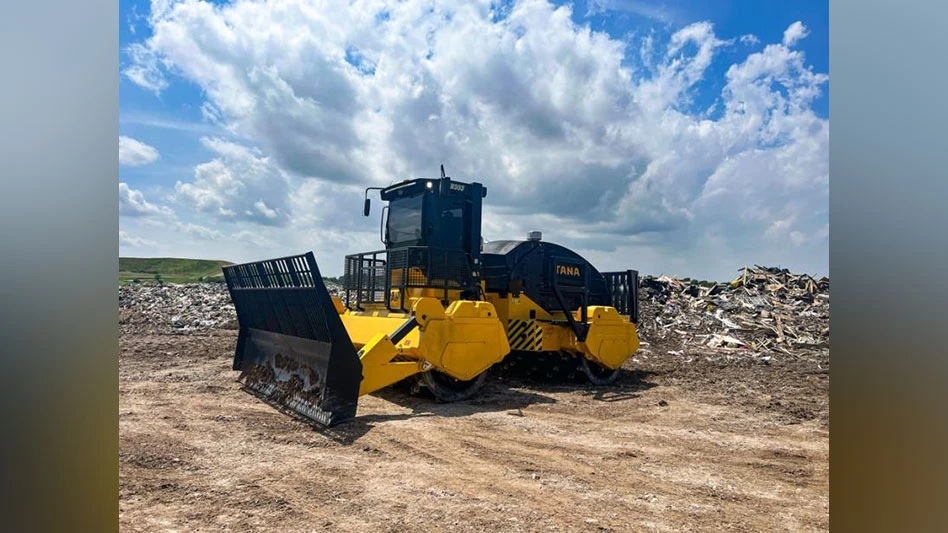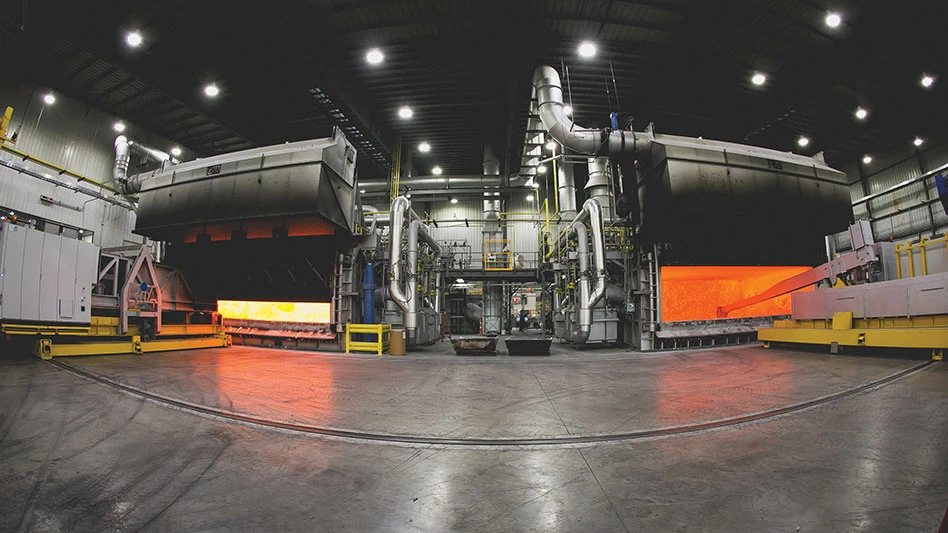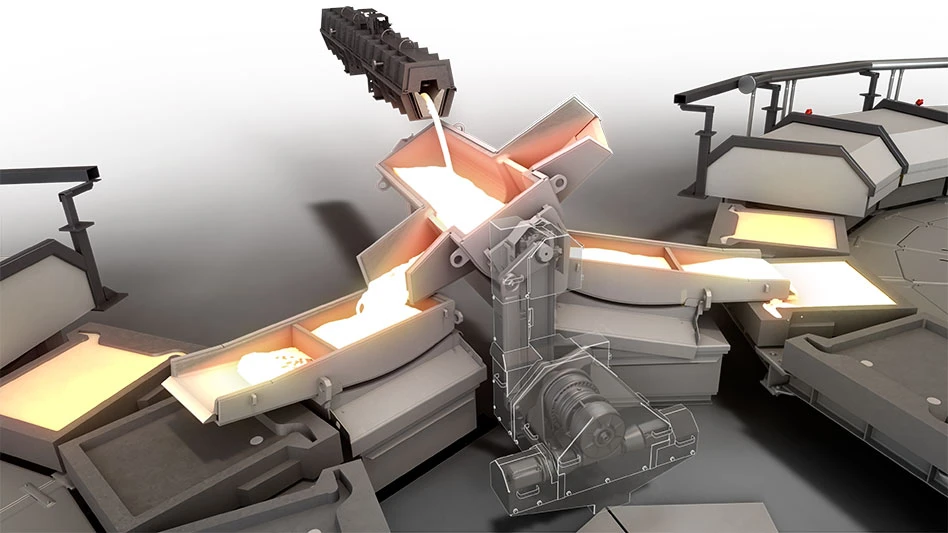
Scrap processors have been using metals shredding plants for several decades to size reduce automobile hulks and other obsolete items into grades of scrap valued by melt shop managers.
It is a form of technology that is far from standing still. Many advances have been made on the downstream side of shredding plants, involving more rapidly and accurately sorting the different metals and materials after the shredding chamber has performed its work.
What is happening within the shredder itself also is far from static, with scrap recyclers and their equipment providers always in the process of upgrading how metal enters the chamber and how it can leave it an optimal condition to be presented to downstream equipment.
Among the techniques being tried at hammer mill-style shredding plants around the world is the placement of a preshredder, a slower-speed, high-torque machine that can break down bales, auto logs and other types of feedstock.
Alone or together
The term auto shredder as it evolved in the last several decades of the 20th century generally referred to large, high-horsepower hammer mill plants into which auto hulks could be directly fed.
These powerful machines continue to perform heavy-duty work in North America and other parts the world, but scrap processors increasingly have options to add preshredding equipment to their size reduction lines.
Metso Recycling, a subsidiary of Finland-based Metso Corp. that has business and engineering offices in Europe, the United States and Asia, says its EtaRip preshredder “is typically installed in front of a typical hammer mill shredder.”
R. Keith Carroll, the U.S.-based director of global sales support for the Metso Recycling product line, says the EtaRip’s “primary use is as a bale breaker, but it can also be used to partially preprocess end-of-life vehicles (ELVs).”
How can adding another piece of somewhat expensive capital equipment yield a return on investment (ROI)?
“By breaking and loosening the bale or ELV prior to feeding the main shredder, the process rate and efficiency of the shredder and downstream [system] is increased by eliminating the surges and gaps typically faced when processing these types of feedstock,” Carroll says.
Skip Anthony of St. Louis-based American Pulverizer Co., which also makes and markets preshredders, says the elimination of those surges and gaps is one of several tangible ROI benefits to having a preshredder. “Operators can realize 20 to 30 percent more production with fewer peaks, thus reducing electrical costs,” he comments.
There are other operating benefits, says Anthony. “The preshredder reduces noise levels and the risk of explosion. It also allows operators to catch unshreddables from entering the secondary hammer mill. This increases wear life and reduces potential damage from the heaviest [unshreddables]. The entire system benefits from a consistent flow of materials for better recovery,” he states.
Italy-based Danieli Centro Recycling, which also has offices and engineers in the United States, United Kingdom and several other nations, offers a variety of preshredder options, some of them part of its Danieli Henschel line.
Jake Allen from Danieli’s U.K. office says preshredders can offer ROI in a number of ways. “The ROI itself is mainly linked to the size of shredder behind the preshredder (higher benefit with smaller shredder),” he comments. “In addition to 10 to 30 percent increased production in the shredder at the same level of electrical consumption, you can expect around 20 percent more anvil and wear parts life span and 20 percent more production with the same hammers in the shredder.”
Other benefits cited by Allen include reduced downtime for the hammer mill shredder because explosions have now been reduced to a minimum likelihood, less environmental impact (noise and emissions) and fewer neighborhood issues because the hammer mill can now operate with a lower horsepower motor.
The right fit
With scrap prices having fallen from their historic highs of the previous decade and flows subsequently reduced, convincing a scrap yard owner that the time is right to invest in a large new piece of equipment may not be easy.
But equipment vendors say there are specific applications and situations where they are indeed convincing plant owners and operators that investing in a preshredder will quickly make sense.
Anthony points to owners of smaller, low-horsepower hammer mill plants as key beneficiaries. “Preshredders are more important when feeding a smaller mill with less horsepower,” he states.
“Years ago, prerippers were installed in front of smaller top-feed shredders to allow them to process autos and other bulky scrap they couldn’t previously process at the lower horsepower,” he comments. “Today the benefits of fewer explosions, catching [unshreddables] and lower electrical peaks are the driving force behind the preshredders.”
Regarding those heavy, unshreddable items that can halt production and even damage a hammer mill plant, Carroll says identifying and rejecting these is among the foremost “safety and operational benefits” of preshredders in auto shredding applications.
“One issue that operators often face with purchased bales or ELVs is the possibility of unshreddables hidden inside. The [preshredder] exposes these large pieces with much less risk than when discovered inside of a hammer mill,” he comments.
“Similarly, gas tanks, pressurized cylinders and other components that could cause explosions if directly fed into shredders are depressurized in a controlled manner, significantly reducing the safety and fire risks associated with the traditional shredding of such items,” Carroll adds.
Vendors also say producers of shredded aluminum grades also have discovered benefits to preshredding. Danieli offers a bale breaker that Allen says is ideal for aluminum scrap size reduction applications. “The high variability in the aluminum incoming feedstock requires a tailor-made solution,” he says.
The Danieli Bale Breaker, he says, includes an “innovative rotor tooth arrangement that increases the productivity per unit power and ensures that not only the large, high-density bales are effectively captured and processed but also small, lower density briquettes.”
Anthony says American Pulverizer has placed preshredders into this same application. “We have a couple of two-shafted machines in baled aluminum [bale breaking] applications,” he says.
The owners of the units are enjoying the advantages of preshredding to the extent that they don’t wish to attract the attention of competing aluminum scrap producers or consumers. “Both end users are very quiet about what they are doing,” Anthony says.
The logic of preparing a constant rate of feedstock for the next stage applies to aluminum shredding just as it does to auto shredding, Allen says, adding that one of the pluses of the Bale Breaker is its ability “to keep high throughput and reliability, allowing the shredder material to be fed inline into a furnace.”
Not every recycler has been convinced that a preshredding device is necessary. Scrap processors who are dedicated to their hammer mill plants may continue to prefer to rely on high-horsepower engines, says Carroll.
“When shredding bales directly with a hammer mill shredder, generally speaking, bigger is better,” he comments. “The larger the machine, the more robust the weldments, castings, rotor and hammers generally are, which allows them to more effectively take the pounding that comes with processing a bale.”
Whether shredding their scrap with one machine or two, plant operators now have numerous options to weigh when it comes to selecting which pieces of equipment will be involved in optimizing their size reduction lines.
Get curated news on YOUR industry.
Enter your email to receive our newsletters.

Explore the August 2016 Issue
Check out more from this issue and find your next story to read.
Latest from Recycling Today
- Fenix Parts acquires Assured Auto Parts
- PTR appoints new VP of independent hauler sales
- Updated: Grede to close Alabama foundry
- Leadpoint VP of recycling retires
- Study looks at potential impact of chemical recycling on global plastic pollution
- Foreign Pollution Fee Act addresses unfair trade practices of nonmarket economies
- GFL opens new MRF in Edmonton, Alberta
- MTM Critical Metals secures supply agreement with Dynamic Lifecycle Innovations





